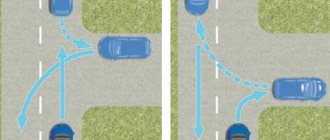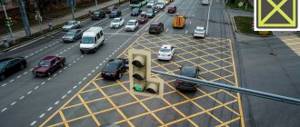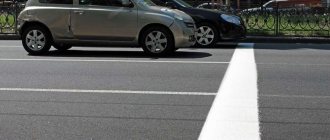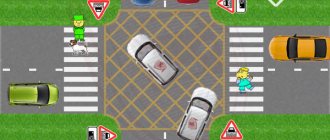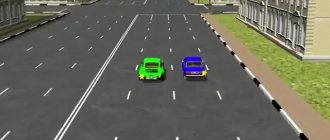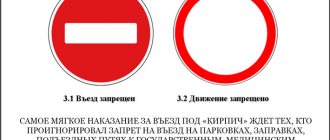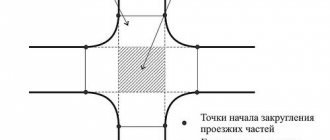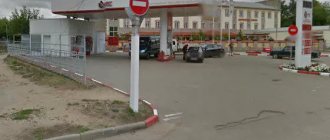When is it worth giving in to someone who is leaving the yard?
Resolving a difficult oncoming traffic situation in a narrow area depends on the common sense and maneuvering capabilities of both participants. Experts advise doing the following:
- The one who has more room for maneuver gives way, first of all, for whom it is safer to drive in reverse.
- If one of the participants lacks common sense and respect for the opponent, then the “Three D” rule applies.
That is, if there is a possibility for several cars to pass in the yard, then it is better to hand it back to the driver of the car leaving. If the yard is narrow or filled with parked cars, then it would be wiser if the car entering the yard gives way.
Experts advise motorists who are planning to turn into a yard with a single-lane driveway not to take advantage of their traffic rules and let cars leaving the yard area pass. This will avoid the situation of “oncoming traffic” on a narrow section. A potential conflict with other road users will cost more than gaining a few seconds on a turn.
Adjacent area on the left
Road in the adjacent territory
1. Turn on the turn, take the leftmost lane, and stop at the turn into the adjacent territory. 2. Having let oncoming traffic pass, drive ahead. 3. When arriving, you must press against the right side of the adjacent territory. 4. As soon as the car is completely hidden, you need to reverse onto the roadway. 5. Be careful and do not drive out in front of a moving car. 6. Back up to the roadway, stop, assess the situation (moving cars), and smoothly drive into the traffic lane. 7. Well, then – moving forward.
As you can see, the maneuver is not difficult
The only thing I want to draw attention to is: learn to think ahead. For example: You need to enter the territory on the left
Having waited for a gap in the traffic, you start moving, drive into oncoming traffic, and a pedestrian is stomping along the adjacent territory. You must miss it. It turns out that your car has stopped across the oncoming lane - not very pleasant. Therefore, before the maneuver, make sure there are no obstacles that may arise: pedestrians, other vehicles, animals, and so on.
By following simple rules, your movement and maneuvers will be simple and confident.
Driving in the adjacent territory according to traffic rules
All sections, elements, structures and objects adjacent to the road belong to the road infrastructure. But this is the case if they functionally coincide with the purpose associated with vehicles and their movement.
The use of such territories has its own Rules, described in the Traffic Regulations (Road Rules).
Violation of the requirements for the proper use of such zones may result in liability in the form of monetary penalties, evacuation of the vehicle to a impound lot, or deprivation of a driver’s license.
The territory adjacent to the highway is those areas and objects that are directly adjacent to the roadway, are part of the road infrastructure, and provide comfortable service for cars or a temporary stop.
But their use must necessarily occur in accordance with the Rules, so as not to violate the general order. Let’s say that when leaving the pedestrian path area, it is prohibited to enter the traffic lane through a turn to the left.
Long-term driving and parking are not permitted on these paths, but you can drive a short distance without people around if there is no stop sign.
Features of such areas and examples:
| Specifics | Examples |
| Isolation or merging with the road. | Any area that extends beyond the line of the roadway, but merges with roads, allowing cars to drive onto them. |
| Performing vehicle maintenance functions | Gas station, for example. |
| Ensuring the safety of passengers and pedestrians | E.g. drive-in pockets for shuttle buses |
| Creating a safe temporary stop for cars that need it. | Road markings - safety islands for emergency stops. |
| Keeping the car away from the moving stream without violating the Rules. | This could be a requirement from a police officer to move off the roadway to an area where a traffic police station is installed. |
Traffic in these (and other) types of adjacent areas is necessarily regulated by the Traffic Rules. Despite the fact that through movement cannot be carried out here, nevertheless, cars also drive along them.
This means that such elements of road infrastructure are also included in high-risk areas due to the presence of moving vehicles on them.
Landscaping may include the installation of road signs to, for example, prohibit leaving the roadway from the yard to the left, etc. Therefore, these areas are subject to traffic regulations.
How to identify areas
How to understand what the adjacent territory is in relation to roads, highways, and highways? Motorists get confused when defining it, mistaking even the courtyards of residential complexes of multi-story, apartment buildings for an adjacent zone. It's actually easy to determine.
Several criteria are important here:
- Close proximity to highways.
- Directly related to automotive topics as intended.
- They are not part of the roadway where machines pass through.
- Movement through such zones is also subject to compliance with the norms of the DD Rules.
The main criterion for the definition is that the car can enter the area adjacent to the roads, can leave it, but it is not possible to carry out through traffic along it.
This means only one thing: these territories cannot be called roads; they do not belong to such a concept as a “roadway.”
Therefore, if this is not a road, then the place where it joins the roadway cannot be called an intersection, because the path leads to a dead end and does not allow the vehicle to move further.
In addition, in relation to the use of places where tracks intersect, the Rules are completely different; they install their own signs and apply completely different markings on the asphalt.
What could be the surrounding area:
- courtyards of residential buildings (only entries from the roadway!);
- neighborhoods;
- residential areas;
- bike paths;
- wide pedestrian paths;
- parking lots;
- gas stations (gas stations);
- zones of enterprises located near roads;
In addition to intersections, courtyard entry and exit routes have similarities between adjacent places and through roads. There is also a roadway there, although not through, as well as sidewalks for pedestrians.
In courtyard areas, pedestrians are given the right to move both along the roadway and on sidewalks.
DD rules for traffic in the adjacent territory
As for the movement of vehicles in the area adjacent to roads, there are a sufficient number of restrictions in force.
The following general rules will need to be observed:
| Scope of application of the standards | Rules |
| Permitted speed | No higher than 20 km/h |
| Driving skills training | Prohibited |
| Keep the car with the engine running | For more than 5 minutes. |
| Park trucks whose weight exceeds 3.5 tons. | Forbidden |
| Park the car on the grass strip. | Strictly prohibited |
| Actions regarding pedestrians | The area is primarily for pedestrians. You need to give way to people on foot. |
But in addition to the general conditions of how to move through the adjacent territory, there are also individual nuances. Thus, the road leading into the yard must be used in a certain way.
Parking and parking in areas of drive-in pockets, “islands” and other places is also carried out in the order determined in the traffic rules. Therefore, all these details should be considered separately.
Entry and exit
The rules for entering or exiting the adjacent territory directly depend on which side it is located in relation to the highway.
Both options should be considered:
| Location | |
| On right | Left |
| 1. You need to drive a little forward.2. Then stop.3. Skip moving cars.4. Reverse into the adjacent territory.5. You can leave only after turning on the left turn signal and adequately assessing the free space between moving cars on the main road. | 1. A signal is turned on, notifying other motorists of the intention to make a turn to the adjacent zone.2. The machine should already be moving on the far left side - closer to the adjacent territory.3. Oncoming cars should be allowed to pass.4. The driver enters the area ahead, but it is advisable to stay on the right side. This must be done in order not to block the exit route for those cars already on the site.5. You should drive out backwards, but only after the driver is completely sure that no one is driving on the main road. |
When it is necessary to leave the adjacent territory, then one single important rule comes into play. First, all moving cars are allowed to pass along the roadway, and then you can drive out to the right.
In this case, you should also pay attention to the movement of cyclists or pedestrians. For example, this must be done when leaving the territory of a gas station (gas station).
Movement
It is also necessary to drive on the adjacent territory, keeping to the right. You should enter or exit from the side that is provided for these purposes - for example, when you need to enter a bus station or gas station.
When driving, it is often very difficult to immediately determine the intersection ahead, or just the adjacent area. Therefore, you should understand how they differ.
Regarding whether to allow a pedestrian to pass or not - in adjacent areas that belong to courtyards or have sidewalks, pedestrians are given priority for movement.
Some restrictions:
- It is forbidden to drive backwards;
- no need to make turns in several maneuvers;
- You should always give way to the one driving on the right.
How to distinguish an intersection from the surrounding area:
| Rule | Orientation |
| Signalized intersections are equipped with traffic lights. | As soon as the driver ahead notices the presence of a traffic light, or corresponding road signs, markings, this means there is an intersection or a turn in front of him. |
| The adjacent territory is not equipped with traffic lights or road signs. | When the motorist ahead does not see traffic lights or signs, he can already understand that this is not a turn or intersection, but an adjacent zone. |
How to make turns and exits
Crossroads of equivalent roads: driving rules
The exit rules are quite simple: you just need to let all road users pass before entering the main road. In addition to cars moving from left to right, you must give way to pedestrians, cyclists and vehicles moving from right to left. If there are road signs at the exit, then you need to be guided by their requirements.
A U-turn in an adjacent area will be different from the same maneuver at an intersection. When turning, you need to take into account which side of the roadway the PT is located.
if the PT is on the right, then you need to drive a little further than the entrance and stop. Then you should let all the cars pass and, without causing interference, turn back to the right. Having traveled the required distance for a turn, you need to turn on the left turn signal and turn, having previously let all the traffic pass; if the PT is on the left, then turning around will be a little more difficult. The vehicle must be located in the far left lane. Having passed oncoming traffic, you need to enter the PT ahead (trying to stay close to the right edge). After entering, you need to turn on the right turn signal, back up and turn the car in the right direction
At the same time, it is important not to interfere with oncoming traffic and pedestrians in the adjacent area.
What are the dangers of maneuvers?
The danger of U-turns lies in the fact that the driver has to move backwards along the roadway, and in some cases, drive into the oncoming lane. U-turns in adjacent areas require extreme caution
They must be carried out quickly and carefully so as not to create an emergency situation for other motorists or pedestrians
Another danger is incorrect identification of the site. If the driver confuses the intersection with the adjacent territory and drives backwards, he will be fined, since such a maneuver is prohibited at intersections.
Before making a maneuver, you need to look carefully to see if there are any signs that prohibit a U-turn. For example, this maneuver will be prohibited on a one-way road. For driving in the opposite direction to that prescribed, the driver will be fined 5 thousand rubles or have his driver’s license revoked.
Controversial road trips
The basic rule that all motorists should remember: when leaving the adjacent territory, you must give way to all types of transport. But the problem may lie in the fact that the driver does not understand whether it is adjacent to him or the intersection. If there are no signs indicating the ownership of a particular road, then you should stick to the right lane and give way to those vehicles moving on the main road.
Exits from parking lots, gas stations, etc. and the entrances to them are organized separately and are accompanied by signs 5.5, 5.6 and 3.1, so there will be no problems with them if the driver has learned the traffic rules. Violation of this rule of entry or exit (travel in the opposite direction) will entail a fine of 5,000 rubles or deprivation of a driver’s license for up to six months.
Exit from a yard or a T-shaped intersection – how to tell the difference?
Why differentiate them? Firstly, to understand whether the sign (prohibiting stopping or speed limit sign) has expired. But often, in order to understand which driver has priority in traffic. After all, a mistake can lead to an accident.
First, let me remind you of the definitions that we need to understand this issue.
“Main road” - a road marked with signs 2.1, 2.3.1 – 2.3.7 or 5.1 in relation to the one being crossed (adjacent), or a road with a hard surface (asphalt and cement concrete, stone materials, etc.) in relation to a dirt road, or any road in relation to exits from adjacent territories. The presence of a paved section on a minor road immediately before the intersection does not make it equal in importance to the one it intersects.
It follows from the definition that there may not be a “main road” sign before leaving the adjacent territory. So how then can you distinguish an exit from an adjacent territory from an uncontrolled T-shaped intersection of equivalent roads? Perhaps the definition of "crossroads" will clarify the situation?
“Intersection” is a place where roads intersect, adjoin or branch at the same level, limited by imaginary lines connecting, respectively, the opposite, most distant from the center of the intersection, beginnings of curvatures of roadways. Exits from adjacent areas are not considered intersections.
It didn't make it clear, unfortunately. What is this “adjacent territory”?
“Adjacent territory” is the territory directly adjacent to the road and not intended for through traffic of vehicles (yards, residential areas, parking lots, gas stations, enterprises, etc.). Movement in the adjacent territory is carried out in accordance with these Rules.
As you know, many adjacent territories are designed in such a way that it is simply impossible to leave at the same place where you entered this territory. In addition, the fact that the adjacent territory is “not intended for through traffic” does not mean that it is impossible to drive through it. In most cases it is possible and this makes drivers even more confused.
A simple example. In many modern cities, wide streets have duplicate roads, so-called “pockets”.
At the entrance to such a “pocket” there is often a sign 5.21 Residential zone, and at the exit, accordingly, a sign 5.22 End of residential zone. Thus, moving along this backup, the driver is already in the adjacent territory, which means the road along which he is traveling cannot be the “main” in relation to any adjacency. Unless there are priority signs installed at such an intersection. In most cases, there are none, which means drivers are required to leave, guided by the “right hand” rule:
8.9.
In cases where the trajectories of vehicles intersect, and the order of passage is not specified by the Rules, the driver to whom the vehicle is approaching from the right must give way.
But in fact, drivers moving along the backup believe that they have priority in traffic and do not give way to those who enter this backup on the right.
Ideally, at every controversial intersection or exit from the adjacent territory, road services are required to install priority signs. But we do not live in an ideal world. So the question remains open. And the advice in this case is simple: if you are not sure which driver has priority in traffic, it is better to slow down and let them pass, or agree on the passing order with the other driver using gestures.
Give it a thumbs up if it was helpful or dislike it if you wasted your time.
Better yet,
subscribe to the channel - you will make the author happy.
How to travel safely
How to navigate an intersection controlled by traffic lights according to the rules in 2020?
In order not to provoke an accident when entering the main road, you need to make sure that there are no obstacles and realistically assess the capabilities of your car. According to general traffic rules, the driver must leave the road intersection immediately after exiting.
The car enthusiast must understand how much time he will spend to complete his maneuver. When driving onto the main road, you need to take into account a number of external factors:
- weather;
- quality of the road surface (crushed stone, sand, clay, etc.);
- extreme visibility;
- the presence of snow, ice or puddles on the road surface.
After entering the intersection, the driver must speed up his car so that other participants cannot catch up with him. You need to be extremely careful and not allow the vehicle to stop, since other motorists follow the rules and know about their advantage and may not slow down when approaching the intersection. As a result, there may simply not be enough time and distance for emergency braking.
Right turn
When leaving a secondary road on the main road, a motorist must follow the rules for crossing intersections, including unregulated ones. When turning right, he must take the extreme right position, make sure there are no obstacles: no one is approaching from the left and no one is making a U-turn from the oncoming lane. Only after this start moving. With such a maneuver, the car should be strictly in the rightmost lane in case of multi-lane traffic.
For example, a person is moving in the right lane with the right turn signal on, having forgotten to turn it off at the previous intersection. Yes, on many cars it turns off on its own, but still. Another traffic participant intends to drive straight ahead with his turn signal on. Having started to move, leaving the additional roadway will provoke an emergency situation. In the event of an accident, it will be quite difficult to prove your case.
U-turn and left turn
When turning or making a U-turn, the driver needs to take the extreme left position closer to the center of the roadway. Next, make sure that no vehicles are approaching from either the left or the right. And only then begin to move to the dividing strip, as soon as you reach it, at this moment, and jump out to the left into your lane.
In the case of a U-turn, the driver must perform the same actions as when turning: drive to the median, enter the lane of passing traffic and turn back. If a motorist decides to turn around right at the edge of the roadway, he will grossly violate the road rules, as he will end up in oncoming traffic. This action is strictly prohibited, as it increases the risk of an emergency, even if no one is moving towards you.
Leaving the surrounding area
According to traffic rules, road users, when entering the main road from an adjacent one, are required to yield to others who have priority over them. This rule applies when traveling from adjacent areas: courtyards, gas stations, etc.
The rules clearly state that such areas are not intersections. However, the order and priority of travel follows the same principle: drivers on the main road have priority. Therefore, a motorist standing on an adjacent roadway is obliged to let others pass in all cases, regardless of the direction of travel.
Driving through intersections
Driving through uncontrolled intersections on a secondary road is regulated by a set of rules, clause 13.9. They determine priority for road users. Cars on the main road have priority. The remaining vehicles must wait until they complete their maneuver, and only then begin to perform theirs.
Other cases
Any maneuver that involves moving from a secondary roadway to the main one must be completed as quickly as possible so as not to interfere with other cars. But before driving, the driver must make sure that his actions are safe. This applies to uncontrolled and signalized intersections. The order of crossing the latter is regulated exclusively by permissive traffic light signals. Such situations are regulated by paragraphs 13.4-13.7 of the Traffic Rules.
A car blocked the entrance to the yard: what to do
If a car has blocked the entrance to the yard for another car, you should do something to eliminate the problem within the limits of the law:
First, talk to its owner to remove the vehicle. Sometimes this situation is forced, short-term, and the driver disturbing others leaves a note with his phone number on the windshield of the car. You can rock or gently kick the car to set off the alarm. Then there is a chance that the owner will quickly show up himself.
If there is no response or it is impossible to find the driver, call the traffic police. You need to explain the situation, give the address and name the registration number of the car blocking the road. The inspector will contact its owner, and it will be easy for the police to find his phone number. If unsuccessful, the traffic police will call a tow truck. The car that has become an obstacle will be removed to a special parking lot. Moreover, its owner will pay for the movement and location of the vehicle there.
If a motorist is blocked from entering the courtyard of the building where he has an apartment, this is illegal, and you need to deal with the homeowners association. It does not have the right to deprive the property owner of the opportunity to enter the territory that is common to all residents of the house. This norm is established by clause 5 of Article 16 of the Law “On the Entry into Force of the Housing Code of the Russian Federation”:
From the moment the land plot is formed and its state cadastral registration is carried out, the land plot on which the apartment building and other real estate objects included in such a building are located passes free of charge into the common shared ownership of the owners of the premises in the apartment building.
And also Article 262 of the Civil Code of the Russian Federation, which states that people have the right to be on land plots that are not closed to public access and to use the objects located on them.
The Supreme Court of the Russian Federation considered a similar case, and the decision was made in favor of the one who was denied entry into the yard by the general meeting. If we are talking about the car of a person who does not live in an apartment building, if there is a legally installed barrier, they have the right to prohibit him from being in this adjacent territory.
There may be a “Do Not Occupy Entry” sign near the entrance to the area, and this requirement must be obeyed. The same designation is attached to gates that close the courtyards of private houses, and there it has the right to exist.
Watch this video about what to do if a car blocks the passage to the yard:
Crosswalk
The safety of pedestrians on the road is the main goal of a pedestrian crossing, which, as a rule, crosses the roadway, and possibly also tram lines. Hitting a pedestrian in such areas is a gross violation of traffic rules, punishable by law.
But... Let's not talk about the bad.
There are a couple of points to make about the pedestrian crossing at this stage.
Note 1.
The pedestrian on this section of the road enjoys virtually complete and unconditional priority. And all drivers must let him pass at the moment when he crosses the roadway at an organized crossing.
But let’s not argue: they say, before stepping onto the roadway, a pedestrian is obliged to make sure that his crossing is safe, etc. This is required by the section of the traffic rules responsible for the duties of a pedestrian (section 4, by the way!).
Dear lovers of truth and lawyers! Russian judicial practice, unfortunately, does not take into account the above provisions of the traffic rules. A pedestrian was hit at a crossing - the driver is to blame! And it can be incredibly difficult to prove otherwise! But it’s practically impossible! Therefore, we postulate: a pedestrian must be allowed to pass when he is at a pedestrian crossing or even has his foot raised above it for the only planned crossing of the roadway (or tram tracks)
Note 2.
The width of the pedestrian crossing is a matter of principle, because a number of maneuvers are prohibited here (overtaking, turning around, reversing, etc.). Therefore, knowing the dimensions of the crossing means protecting yourself from traffic violations and liability for this.
If a pedestrian crossing is marked with a zebra crossing (combined with or without signs), then the width of the crossing will correspond to the width of the markings.
If there is no marking (or it is indistinguishable, for example, in winter), then the width of the transition will be the distance between the signs.
Passing pedestrian crossings is a special topic. It became the subject of consideration of the special 14th section of the traffic rules
This circumstance indicates the special importance of the problem
Controversial road trips
Let's look at a couple of ambiguous situations (panorama 1 and panorama 2):
Look carefully at the pictures above and answer the question what is shown in each of them: an intersection or an exit from the adjacent territory?
Have you thought about it? Do you understand that everything is not so simple? In none of these examples is it possible to understand what is in front of us without taking the given exits. Those. The first conclusion that we will draw from the results of this article is that it is not always possible to understand what is in front of us: an intersection or the intersection of roadways.
Therefore, I propose to consider the signs that will help us further understand what kind of object is in front of us.
U-turn
Very often the section of road you are talking about is conveniently used to make a U-turn without violating the rules. But in this case, it is worth studying the methods of turning around from the adjacent territory and remembering what rules to follow.
So, we make the correct turn from the adjacent territory, which is located:
RIGHT - move a little further from the entrance, slow down, let cars pass, then “back up” into the alley, then assess the situation, drive out onto the main road, letting other traffic participants pass, and calmly continue on your way - with this maneuver you can clearly see what is happening, you can assess what is happening and react in a timely manner;
It is important to make sure that a pedestrian or cyclist will not interfere with your maneuver - stopping during the race and interfering with other cars that are rushing out of the way of your race is extremely undesirable. Everything needs to be done quickly – “without noise and dust”
How does an intersection differ from the surrounding area?
Good afternoon, dear reader.
Today we will consider another controversial issue of traffic rules. We will talk about how to determine what is in front of your car: an intersection or an exit from the adjacent territory .
In fact, many drivers do not think about this issue until they find themselves in an ambiguous situation.
Let me remind you that the rules for driving through adjacent territories and intersections are somewhat different. For example, reversing at intersections is prohibited. The rules of priority when driving through equivalent intersections and exits from adjacent territories also differ.
In this article, we will look at signs that can accurately identify an intersection or surrounding area, as well as signs that do not give us any information about the roadway being crossed. Let's get started.
Does leaving the yard invalidate the signs?
According to the Russian Federation Traffic Regulations, the effect of many prohibitory signs extends from the place where the sign is installed to the nearest intersection behind it. That is, after passing the intersection the sign is no longer valid.
But does this rule apply to exits from the yard adjacent to the main road? Let's try to figure it out.
Several years ago, the Supreme Court of Russia considered a very interesting case, in which a resident of Voronezh challenged the fine issued to her for parking under the sign “3.27. Stopping is prohibited."
The car enthusiast’s arguments were very simple: in her opinion, she parked her car after the exit from the yard adjoined the main road, and therefore, the effect of this sign no longer applied to this area.
Having reached the highest court, the lady motorist challenged not only her fine, but also, in general, the interpretation of the term “intersection” existing in the traffic rules, believing that our Rules contradict the Vienna Convention on Road Safety, which states that any intersection of roads is an intersection .
Having considered the case, the Supreme Court of the Russian Federation considered that the Russian traffic rules do not contradict the Vienna Convention, and the exit from the yard is not an intersection and rejected the complaint.
Thus, the attempt to break the existing state of affairs, according to which leaving the yard does not cancel the effect of the “No Stopping” sign, failed.
Adjacent area or intersection
The surrounding area is not just
First, let me give you a definition. “Adjacent territory” is the territory directly adjacent to the road and not intended for through traffic of vehicles (yards, residential areas, parking lots, gas stations, enterprises, etc.). Movement in the adjacent territory is carried out in accordance with these Rules."
It would seem that everything is simple. But as I showed before.
a road may have "parking lanes" which, although not intended for through traffic, are part of the road. Conversely, there may be roads in the surrounding areas.
For example, houses must be located at a distance of at least 25 meters from highways, and a road leads to the adjacent “yard” area, called a “passage” in official documents.
Will the definition of the term “adjacent territory” return to the traffic rules?
After all, it appears in the rules, but there is no clear description now.
If we take into account the absence of this term, then the place where the exit from the yard intersects with the roads is an intersection. According to clause 7.8. The list of malfunctions and conditions under which the operation of vehicles is prohibited, in the traffic rules of the Republic of Kazakhstan, a medical first aid kit and a warning triangle (flashing red... No, due to the changes in the traffic rules that came into force from January 7, 2015, it is not possible to turn on low beam headlights in the cases described by you required.
Comments on - Adjacent territory or intersection?
I am categorically against the conclusions made in the article!! Why do you allow yourself to give advice based on “ideas”?? The traffic rules clearly state: “Intersection” is a place where roads cross, join or branch at the same level, limited by imaginary lines connecting respectively the opposite, most the beginnings of curvatures of roadways located far from the center of the intersection. That is, if an adjacent road intersects the roadway on which you are moving AT THE SAME LEVEL, and there are no signs in front of this adjacent road, it means that this is an intersection of equivalent roads.
“Intersection” is a place where roads intersect, adjoin or branch at the same level, limited by imaginary lines connecting, respectively, the opposite, most distant from the center of the intersection, beginnings of curvatures of roadways.
Leaving the surrounding area
For motorists, there are many controversial issues regarding traffic rules.
Moreover, this applies to both experienced and novice drivers. Even if it seems to you that you have a perfect understanding of traffic rules, changes in the rules can raise many questions.
One of these issues is leaving the adjacent territory. The driving instructors of our portal decided to sort out the controversial issue for readers. There is a certain inaccuracy that is present in traffic regulations and can often confuse drivers. The fact is that not everyone knows whether the adjacent territory can be a roadway or is it just an element of the road. So, according to clause 1.2. Traffic regulations, the adjacent territory is not a roadway, since this territory is not intended for through traffic, and therefore cannot be considered a full-fledged road.
Traffic rules lessons: is an uncontrolled intersection always such?
Asked by Alexey Kakava. Obukhov, Kyiv region. Unregulated intersection. There are no priority signs on all sides.
Paragraph 16.11 of the Ukrainian Traffic Regulations states:
“at an intersection of unequal roads, the driver of a vehicle moving on a secondary road must give way to vehicles approaching this intersection of carriageways on the main road, regardless of the direction of their further movement.”
It seems like an intersection of equivalent roads here. Please explain how to get through this intersection if cars are approaching it from all sides and need to continue moving straight. Karat driving school experts answer: This intersection of roadways is not an intersection.
This is leaving the residential area (adjacent territory). According to paragraph 10.
Cars are trash
One foreign car crashed into the right side of another at a road intersection.
Who is guilty? If there are no signs, skip the obstacle on the right.
Evgeniy believes that the girl driving the Lexus should have let him pass, as she was leaving the adjacent territory. “Yes, there are no signs,” says the man.
What signs can help a driver distinguish an intersection from an “exit from the adjacent territory” if he is driving along a conditionally main road in an unfamiliar area/city? From the time I studied at a driving school, I remember that if there is a “give way” sign on the adjacent path, then it seems like there is already an intersection, regardless of the presence of other signs on the road.
(a) “Intersection” - a place where roads intersect, join or branch at the same level, limited by imaginary lines connecting the opposite, respectively, points of curvature of roadways that are most distant from the center of the intersection. Exits from adjacent areas are not considered intersections. (b) “Adjacent territory” - the territory directly adjacent to the road and not intended for through traffic of vehicles (yards, residential areas, parking lots, gas stations, enterprises, etc.).
(e) 2.4 “Give way.”
Sign Exit from a residential area () maybe before the intersection?
In this photo you can see that sign 5.22 has been installed, and it in turn means “Sign 5.22 “End of residential area” shows that you are leaving a residential area, which belongs to the adjacent territory.
Therefore, when leaving a residential area, the vehicle driver is obliged to let both pedestrians and other vehicles pass, regardless of the direction of their movement.”
The above statement can only be true if a) There are no roads in a particular residential area.
Intersection or adjacent area (traffic ambiguities)
Crossroads or surrounding area? Let's try to understand this issue together, since there are differences not only in meanings, but in travel rules.
Reversing is prohibited at intersections when there is no exit from the adjacent territory. Also, the rules when driving through an equivalent intersection differ from driving through intersections with the adjacent territory.
Exits from adjacent territories do not cancel the validity of road signs. The coverage area of signs 3.16, 3.20, 3.22, 3.24, 3.26 - 3.30 extends from the place where the sign is installed to the nearest intersection behind it, and in populated areas, in the absence of an intersection, to the end of the populated area.
Road sign 5.21 “Residential zone”
The concept of “residential zone” is discussed in detail in section 17 of the traffic rules
For violation of these requirements, quite significant fines are provided, up to and including deprivation of rights for 12 months, so attention should be paid to studying them. In this article we will try to answer the questions:
- what is a residential zone, what signs are used to indicate it;
- rules of movement, parking and stopping within such territories;
- what punishments and fines are provided for under the Code of Administrative Offences.
“A specially developed area where special traffic regulations apply. Entrances and exits are marked with signs 5.21 and 5.22, respectively.”
Already from the name it is clear that such areas are located within residential areas, in areas where multi-storey or private houses are built. The main advantage in movement here is given to pedestrians and cyclists, therefore serious restrictions apply, including:
- to the speed of movement of vehicles;
- to the rules of stopping and parking;
- to exit and entry.
It should also be noted that these requirements are relevant for courtyards and adjacent territories, however, the Civil Code of the Russian Federation and traffic rules do not provide a definition of the terms “household or courtyard areas”. Thus, you need to focus on signs 5.21 and 5.22. If they are not there, then a speed limit sign is usually posted: 3.29 to 20 or 5 kilometers per hour.
We invite you to familiarize yourself with the Features of regulating the eviction of citizens from residential premises
An important point is that traffic police and traffic police patrol cars rarely enter the courtyards of houses, so drivers often take advantage of this by exceeding the speed limit and placing their vehicles on playgrounds and lawns.
Residents of houses can teach violators a lesson by reporting this, for example, through the application form on the official website of the traffic police.
This sign provides for the following rules:
- The presence of the sign implies a speed limit of 20 km/h.
- Pedestrians have the right of way, meaning the driver must always let them pass. True, pedestrians are prohibited from deliberately blocking the roadway and interfering with traffic.
- The adjacent areas are not intended for through passage; they cannot be used to shorten the route. By the way, this is what many drivers do when they want to take shortcuts or drive through yards, but they do not adhere to speed limits.
- It is also not allowed to use such zones to perform various maneuvers: turns, driving in reverse.
Among other things, the following are prohibited in residential areas:
- training ride;
- parking with the engine running;
- parking for vehicles belonging to category “C”, that is, cargo weighing more than 3.5 tons (subject to the absence of separate permitting signs and markings).
The last point says that even if you need to transport furniture, the truck cannot remain within the local area for more than 5 minutes. However, this requirement does not apply to trucks with a special plate, as well as public utility vehicles.
Leaving a residential area is equivalent to leaving any other adjacent territory; accordingly, you must adhere to the following requirements:
- give priority to all road users who move along the main road - pedestrians, drivers of other vehicles, motorcyclists, cyclists - regardless of the direction of their movement;
- When exiting, it is prohibited to cross a solid marking line (if there is one), that is, you can only turn to the right.
Well, a common violation that deserves special attention is parking on lawns or areas. You can only park your vehicle in designated parking areas.
If a person violates any of the above requirements, he will face the following fines:
- 1500 rubles or 3000 for Moscow and St. Petersburg - failure to comply with entry/exit rules, through driving, failure to give priority to pedestrians, parking with the engine running (12.28 Code of Administrative Offenses);
- parking on the lawn, children's playground - each region has its own fine amount (in Moscow up to 5,000 rubles).
Speeding is a special issue - the same rules apply here as for general roads:
- that is, if you exceed 20-60 km/h, you need to pay a fine;
- if you exceeded it by 80 or more, then you will be deprived of your driving license.
Turn signals
Clause 8.1. Traffic regulations oblige drivers, before any maneuver, excluding reversing, to give the appropriate turn signal before turning the steering wheel in one direction or another. For this purpose, special flashing light indicators are used, located in front, behind and on the sides of the vehicle. The turn signals turn on in the direction in which the steering wheel should turn. In the event of a malfunction or absence of light indicators, the driver indicates his intention to turn by using his arm extended in the desired direction. The requirement to use turn signals is mandatory in all situations, even when maneuvering in a parking lot or in a yard. Turn signals are not used when driving around a curved road that is not a maneuver. In a situation where there are several directions for driving, the driver must notify other road users in which direction he intends to go. Failure to use a turn signal indicates an intention to drive straight.
Turn signals help clarify traffic situations. However, other drivers and pedestrians are not required to allow vehicles with their turn signal on to pass. It is the driver making the maneuver who must give way. Giving a turn signal does not give him the right of way.
The habit of warning others about your upcoming maneuvers in all situations significantly reduces the risk of getting into an accident.
Clause 8.2. Traffic rules state that turn signals must be turned on well before the start of the maneuver and turned off after it ends. A hand signal in case of missing or faulty light indicators is also given in advance of the maneuver and stops before it is carried out due to the need to ensure the safety of the vehicle entering the turn.
Clause 8.2. also suggests that in a situation where the driver’s intentions can be ambiguously understood, one should refrain from giving a signal. To do this, you need to choose the right moment when it will indicate one specific action.
Normally, the turn signals turn off automatically when the maneuver is completed. However, with small turns of the steering wheel, automatic shutdown may not occur. Accordingly, the driver should carefully ensure that the turn indicators are turned off. In this case, indicator lamps on the dashboard and a special sound signal will help him.
If there is a malfunction or absence of external light direction indicators, the driver must give signals informing about his maneuvers with his right or left (depending on the location of the steering wheel) with his hand extended to the side or bent at the elbow. If the rear brake lights or brake lights are faulty, a signal in the form of a raised hand is given each time you brake.
Traffic at an intersection
Now let's take a closer look at what main points need to be taken into account when driving at an intersection. In general, this point is very difficult. Everything is taken into account:
As you can see, there are indeed many complicating factors. But it's okay. What basic rules should you follow when you decide to drive through an intersection?
- Pay close attention to other people's movements.
- Slow down when approaching road intersections.
- A street intersection is a place where you need to pay special attention to the behavior of the car.
- Turn in the right lane. If you need to turn left, then you should move along your road for some time, smoothly turning in the right direction, so that you end up in the right lane of the perpendicular road. But be careful: this maneuver can be dangerous for your life. It's much easier and safer to find a single road that you can use to get there.
- If you see an agricultural vehicle, be prepared for the fact that it cannot maneuver as quickly as a passenger car. It seems like a simple tip, but for some reason many drivers forget about it.
Requirements for drivers who find themselves at such intersections
A large number of rules and regulations boil down to requirements that need to be met not only at intersections:
- give way to the vehicle on the right;
- monitor traffic participants - where they want to turn - their turn signals will indicate this;
- do not continue driving until it is clear that all other road users are giving way to you or have passed.
So, it’s interesting that giving way does not mean stopping every time. It is enough to slow down before the intersection and slow down a little. The main goal is not to interfere with the passage of those vehicles that are at the intersection.
For example, a motorcyclist needs to turn around. If he was driving towards you, you should wait until he is completely ahead and ready to continue driving. If he is on the right, yield according to the “interference on the right” rule. In the event that the motorcyclist is on the left, and no one else needs that side, the trajectories will not intersect and maneuvers can be performed by several road users at once.
Who must give way: cars when entering or leaving the yard?
This situation, as in the photo above, occurs very often and drivers, not fully understanding the current traffic rules, begin to argue, swear and threaten each other, and sometimes it comes to a fight with bodily injuries. I observe such conflicts very often and have encountered a similar situation myself.
You are entering the yard
So, your car turns off the main road and turns into the courtyard. Here you need to adhere to traffic rule 8.3, according to which you must give way to absolutely all pedestrians, as well as cyclists, and then move along your route.
It should also be added that it does not matter in which direction the pedestrians move. In this case, they are always more important. Also, according to clause 8.5., your car must take the most extreme position in advance before entering the yard.
You are leaving the yard
Again, you need to refer to paragraph 8.3, which clearly states that in this situation you need to give way to the same cyclists, pedestrians, and vehicles. In other words, you must give way to absolutely everyone! By the way, not many car owners know about this and foam at the mouth to prove that they are right.
How to pass each other in the yard
This is a typical situation when one car has already turned into the adjacent territory and has driven a few meters, and the second is leaving the yard, and the road itself does not allow two cars to pass each other at once. This is where the hottest debates and constant conflicts begin.
If we turn to clause 8.3 of the traffic rules, then it does not apply, since the car has already driven into the yard. Both drivers find themselves in a so-called “oncoming traffic” situation. I read the traffic rules several times and did not find a clause that would regulate this option. This situation can be interpreted as one where both drivers can be considered right, but the passing maneuver itself relies solely on the prudence of both car owners.
Here's what to do:
Although there are unwritten rules that I recommend always following:
— Before entering the adjacent territory, you need to release absolutely all cars that leave the yard
— If you have already entered the yard and there is another car in front of your hood, then the car that has the most room for maneuver should go back.
Always adhere to these rules and avoid unnecessary conflict situations! Peace and goodness to everyone!
